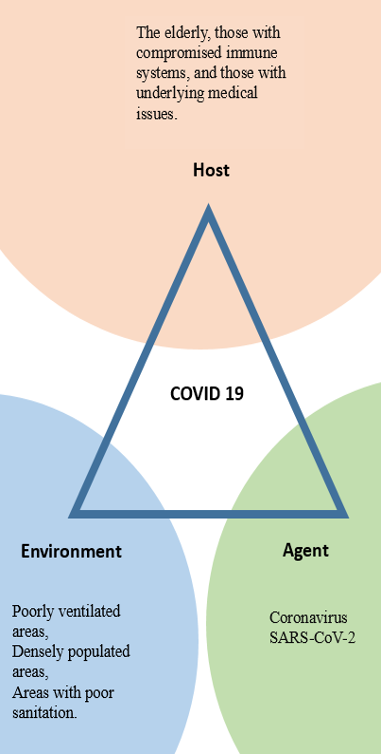The COVID-19 pandemic, which resulted in millions of infections and hundreds of thousands of fatalities, profoundly affected humanity. The illness was correctly identified in Wuhan, China, in December 2019. It has since quickly spread throughout the populace, necessitating lockdowns, travel bans, and a wide range of significant public health measures (Ciotti et al., 2020) when infected individual coughs, talks, or sneezes, respiratory droplets from the SARS-CoV-2 virus (the source of COVID-19) are mostly spread.
Epidemiology Triangle of COVID-19:
The epidemiology triangle of COVID-19 consists of three factors: the host, the agent, and the environment. The host refers to the human infected with the virus, the agent is the virus itself. Finally, the environment includes the physical and social factors that contribute to the spread of the virus.
The host component of the epidemiology triangle refers to the organism or individual that becomes infected with the disease. In the case of COVID-19, the host is human. COVID-19 is highly contagious and can spread through respiratory droplets generated when an infected person coughs, sneezes, or talks (Ciotti et al., 2020). Transmission can also occur through contact with contaminated surfaces or objects. Although the illness can strike anybody, some groups are more susceptible to severe illness or even death, such as the elderly, those with compromised immune systems, and those with underlying medical issues. The infective agent that causes the disease is called the agent component. A group of viruses known as coronaviruses are responsible for respiratory illnesses in humans and animals. SARS-CoV-2 is highly infective and can cause terrible respiratory illness, including pneumonia, incisive respiratory distress syndrome (ARDS), and death. It is difficult to develop effective treatments and vaccines because the virus has a high mutation rate, which enables it to adapt and evade the human immune response. The SARS-CoV-2 virus spreads exceptionally quickly due to its high rate of transmission. Since the virus can spread even among those who show no symptoms, it is challenging to stop its growth.
Environment:
The environment of the relationship between the host and agent is referred to as the environment in the epidemiology triangle. In the case of COVID-19, the environment includes both physical and social factors. The virus can survive on surfaces for several hours, making contaminated surfaces a potential transmission source. Indoor environments with poor ventilation can also increase the risk of transmission (Ciotti et al., 2020). Additionally, social factors such as population density, travel, and adherence to public health measures such as wearing masks, physical distancing, and vaccination can impact the spread of the disease. In overpopulated regions, such as cities, where people live near each other, COVID-19 spreads fast. Insufficient ventilation, poor sanitation, and crowded living circumstances can all contribute to the spread of the virus (Morens & Fauci, 2020). For example, meatpacking plants and nursing home outbreaks have been linked to poor ventilation and crowded conditions.
Examples of the Epidemiology Triangle in Action
Using a COVID-19 epidemic at a nursing home as an example to show how the epidemiology triangle works. The SARS-CoV-2 virus is the agent, the nursing home is the host, and the home is the environment. Due to their advanced age and underlying medical issues, nursing home patients are more likely to experience severe illness and even pass away from COVID-19 (Morens & Fauci, 2020). If one person contracts the virus, they can quickly infect other residents and staff members by coming into close contact with them.
The virus can last on surfaces for several hours, increasing the danger of transmission through fomites. In addition, the crowded living conditions and shared spaces in a nursing place can step-up the danger of transmission. Finally, the societal factors affecting the nursing home, such as staffing shortages and inadequate personal protective equipment, can further increase the risk of transmittal and make it hard to control the outbreak.

Conclusion:
The COVID-19 pandemic has profoundly impacted the world, with millions of people affected and hundreds of thousands of lives lost. The epidemiology triangle provides a valuable framework for apprehension on how the virus spreads and affects individuals and populations. The host, agent, and environment are the three components of the triangle, and each plays a crucial role in the spread and brutality of the disease. The virus primarily spreads through respiratory droplets when an infected person talks, coughs, or sneezes, but it can also be transmitted through contact with contaminated surfaces or objects. Specific populations, such as the elderly and immunocompromised individuals, are at higher risk for severe illness or death. The virus has a high mutation rate, which makes developing effective treatments and vaccines challenging. The environment, including physical and social factors, also plays a critical role in the spread of the disease. Adherence to public health measures such as wearing masks, physical distancing, and vaccination can facilitate control of the spread of the disease.
References
Ciotti, M., Ciccozzi, M., Terrinoni, A., Jiang, W. C., Wang, C. B., & Bernardini, S. (2020). The COVID-19 pandemic. Critical reviews in clinical laboratory sciences, 57(6), 365-388.
Morens, D. M., & Fauci, A. S. (2020). Emerging pandemic diseases: how we got to COVID-19. Cell, 182(5), 1077-1092.
 write
write